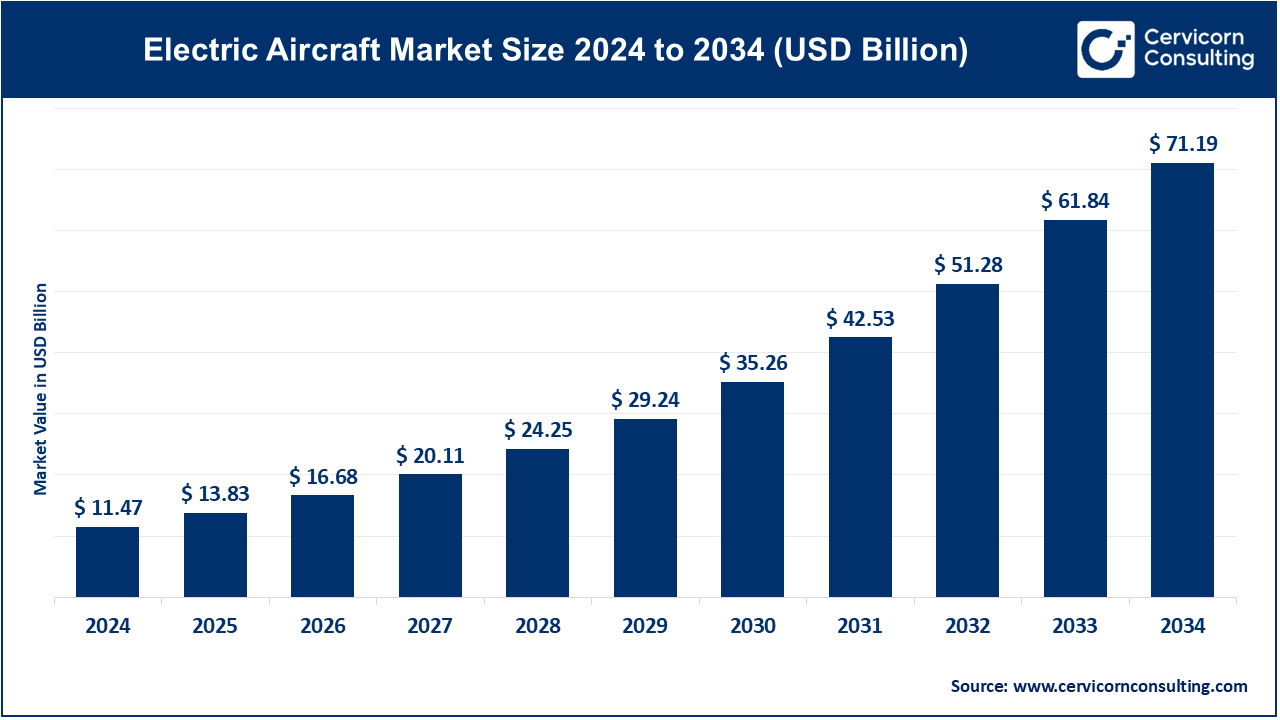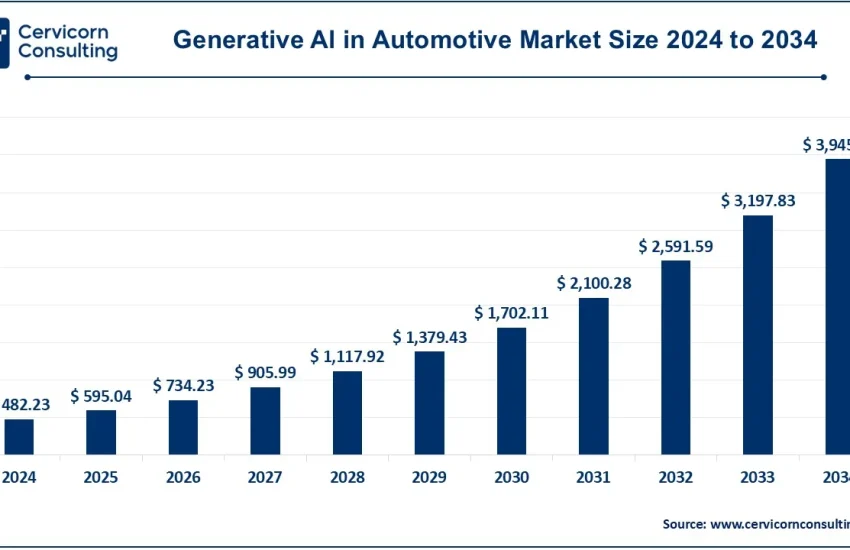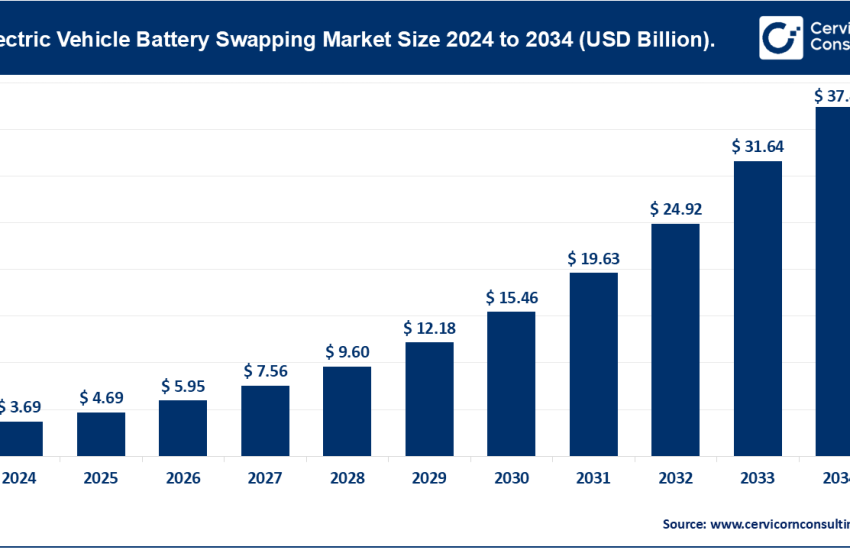Electric Aircraft Market Growth, Companies, and Global Presence 2025 – 2034
Table of Contents
ToggleElectric Aircraft Market Overview
The global electric aircraft market was valued at USD 11.47 billion in 2024 and is projected to grow to approximately USD 71.19 billion by 2034, with a compound annual growth rate (CAGR) of 20.02% from 2025 to 2034.
The Electric Aircraft Market has been experiencing robust growth, fueled by a variety of key factors such as the growing demand for environmentally sustainable transportation, rising fuel costs, and the advancement of battery and electric propulsion technologies. Governments worldwide are pushing for greener aviation technologies to reduce carbon emissions, thereby incentivizing investments in electric aircraft development.
Additionally, the significant reduction in aircraft operating costs due to lower energy consumption, the push for urban air mobility (UAM), and the increasing need for energy-efficient aircraft systems are key drivers behind the market’s expansion. The market’s growth is also influenced by the need to create quieter, more efficient aircraft for both commercial and private use, with hybrid and fully electric propulsion systems gaining traction. As technological innovation continues, the push for sustainable aviation solutions is expected to increase the pace of the electric aircraft market’s growth in the coming years.
What is the Electric Aircraft Market?
The Electric Aircraft Market refers to the segment of the aviation industry focused on the development and commercialization of electric-powered aircraft. These aircraft are either partially or fully powered by electric motors that are driven by energy stored in batteries or generated through alternative means such as hybrid engines. Electric aircraft can range from small drones used for commercial delivery services to urban air mobility (UAM) aircraft and potentially even larger regional planes that are entirely electrically powered. The market encompasses various categories of electric aircraft, such as fixed-wing aircraft, eVTOL (electric vertical take-off and landing) aircraft, and hybrid-electric aircraft, all contributing to the push toward sustainable and efficient aviation solutions.
Why Is It Important?
The Electric Aircraft Market is crucial for several reasons. As global environmental concerns grow, reducing carbon emissions from the aviation sector, which is a significant contributor to greenhouse gases, is a priority. Electric aircraft represent a major step forward in reducing the ecological footprint of aviation. These aircraft promise lower operational costs, such as fuel consumption, which translates into more affordable and efficient travel options. Electric aircraft also contribute to reducing noise pollution, making them ideal candidates for urban air mobility and short regional routes.
Furthermore, technological advances in electric propulsion and battery systems are pushing the limits of what electric aircraft can achieve in terms of range, efficiency, and passenger capacity, making them an essential part of the future of air travel.
Get a Free Sample: https://www.cervicornconsulting.com/sample/2330
Companies, Specialization, Key Focus Areas, and Notable Features
- Airbus SE
- Specialization: Airbus is a global leader in aerospace, focusing on both commercial and military aircraft. In the electric aircraft segment, the company is investing in sustainable aviation technologies through projects like the E-Fan X, which aims to develop hybrid-electric propulsion systems for commercial aircraft.
- Key Focus Areas: Hybrid-electric propulsion, sustainability, advanced avionics, and energy-efficient aircraft design.
- Notable Features: Airbus has pioneered the development of electric aircraft with its E-Fan program, and its recent initiatives are focused on reducing carbon emissions through electric and hybrid-electric solutions.
- Boeing Company
- Specialization: Boeing is a major player in the aerospace and defense sectors. While it has primarily focused on traditional aircraft, Boeing has entered the electric aircraft market through investments in companies like Zunum Aero and by developing electric propulsion technologies for future aircraft.
- Key Focus Areas: Battery technology, electric propulsion, hybrid-electric aircraft, and partnerships to drive innovation.
- Notable Features: Boeing’s partnership with Zunum Aero for hybrid-electric aircraft and their involvement in the development of fully electric vertical take-off and landing (eVTOL) aircraft demonstrate its commitment to the electric aircraft sector.
- Pipistrel d.o.o Ajdovščina
- Specialization: Pipistrel is a renowned manufacturer of light aircraft, with a significant focus on electric aircraft. The company is one of the first to introduce fully electric aircraft for commercial use.
- Key Focus Areas: Light electric aircraft, innovative battery technology, and efficient aerodynamics.
- Notable Features: Pipistrel’s Alpha Electro electric trainer aircraft is one of the leading models in the electric aviation space, known for its efficiency and low operating costs.
- Siemens AG
- Specialization: Siemens is a global technology giant that has been working on integrating electric propulsion systems into the aviation sector, partnering with companies to develop hybrid-electric and fully electric aircraft engines.
- Key Focus Areas: Electrification of aircraft, development of efficient electric motors and battery systems, and energy management solutions.
- Notable Features: Siemens’ work on electric motors and control systems has made significant strides in the development of commercial electric aircraft, including collaborations on projects like the E-Fan X.
- Zunum Aero
- Specialization: Zunum Aero focuses on the development of hybrid-electric aircraft for regional travel, with a goal to revolutionize short-haul flights.
- Key Focus Areas: Hybrid-electric propulsion, regional air travel, and battery development for commercial aircraft.
- Notable Features: Zunum Aero’s 12-seat hybrid-electric aircraft are designed to reduce emissions and operating costs for regional airlines, making them a key player in the transition to electric air travel.
2023 Revenue (Approx.) & Market Share (Approx.)
The revenue from the electric aircraft market is projected to grow at a significant pace in the coming years, with estimates indicating a market size reaching around $20 billion by 2030. In 2023, the global electric aircraft market revenue is estimated to have been approximately $2.5 billion, with a compound annual growth rate (CAGR) of 15-20%. The market share of individual companies in this space varies, with Airbus and Boeing leading in terms of investments and initiatives, while smaller players like Pipistrel and Zunum Aero have been making significant advancements in aircraft prototypes and technology demonstrations. These companies are expected to capture substantial shares of the market as electric propulsion technology matures and commercial applications become more viable.
Global Presence – Global Electric Aircraft Market Top Companies
- Airbus SE: With a strong global presence, Airbus operates across multiple continents, focusing on sustainable aviation solutions, including electric aircraft. The company’s major research centers and development initiatives are based in Europe, with collaborations spanning the Americas and Asia.
- Boeing Company: As one of the largest aerospace companies in the world, Boeing has a significant global footprint, operating in North America, Europe, and Asia. Its ventures into the electric aircraft sector have positioned it as a leader in hybrid-electric aircraft development.
- Pipistrel d.o.o Ajdovščina: Pipistrel’s electric aircraft are being used in Europe and North America, with its Alpha Electro aircraft in particular gaining attention as an electric trainer plane. The company has a strong presence in the light aircraft sector.
- Siemens AG: Siemens has a more indirect presence in the electric aircraft market through its partnerships and technology offerings, supporting the electrification of aviation worldwide.
- Zunum Aero: Based in the United States, Zunum Aero is focused on developing hybrid-electric aircraft for regional air travel, primarily targeting North America but with future plans to expand globally.
Leading Trends and Their Impact
Several leading trends are shaping the future of the electric aircraft market:
- Urban Air Mobility (UAM): The rise of electric vertical take-off and landing (eVTOL) aircraft is paving the way for urban air mobility solutions. These aircraft aim to provide efficient, low-emission transportation within cities, which could revolutionize urban travel, reduce congestion, and provide new opportunities for air taxi services.
- Battery and Propulsion Advancements: As battery technology continues to evolve, electric aircraft are becoming more viable for commercial use. Improvements in energy density, charging time, and weight reduction are critical to making electric aircraft competitive with traditional jet engines.
- Sustainability and Environmental Concerns: With increasing pressure on industries to reduce carbon emissions, the electric aircraft market is driven by the aviation industry’s push for more sustainable practices. Airlines and governments are investing in cleaner alternatives, with electric aircraft becoming a focal point for achieving carbon neutrality in aviation.
- Government Incentives and Regulations: Governments worldwide are setting ambitious environmental targets, providing subsidies and tax incentives to manufacturers and airlines adopting electric aircraft technology. These policies are accelerating the transition to electric aviation.
Successful Examples of Electric Aircraft Market Around the World
Several successful examples highlight the progress in the electric aircraft market:
- Pipistrel’s Alpha Electro: One of the first commercially available electric aircraft, the Alpha Electro is used as a trainer aircraft and has been well-received due to its low operating costs and environmentally friendly operation.
- Airbus E-Fan X: Although still in the development phase, the E-Fan X is a hybrid-electric aircraft that promises to showcase the future of electric commercial aviation. Its success will significantly impact the adoption of hybrid-electric propulsion systems in larger aircraft.
- Zunum Aero’s Hybrid-Electric Aircraft: Zunum Aero’s hybrid-electric aircraft, designed for regional air travel, represents a successful example of electric aviation’s potential to disrupt short-haul flights.
Regional Analysis Including Government Initiatives and Policies Shaping the Market
North America: The U.S. is a leader in electric aircraft development, with significant investments from companies like Zunum Aero and Boeing. Government policies are pushing for low-emission solutions in aviation, with the U.S. Federal Aviation Administration (FAA) supporting initiatives to integrate electric aircraft into the airspace. Several state-level incentives also encourage the development of electric aircraft and infrastructure.
Europe: Europe is home to several electric aircraft initiatives, including Airbus’ E-Fan X and Pipistrel’s Alpha Electro. European Union policies focus heavily on reducing aviation emissions, and several governments offer grants for the development of sustainable aviation technologies. The European Commission is pushing for the electrification of aviation as part of its Green Deal.
Asia-Pacific: The Asia-Pacific region is emerging as a significant market for electric aircraft, with Japan and China leading in the development of electric propulsion systems. Governments in these regions are investing in electric air mobility and providing incentives for manufacturers to develop electric aircraft, particularly for regional travel and air taxis.
Middle East and Africa: While the market for electric aircraft is still in its nascent stage in the Middle East and Africa, governments in the region are beginning to invest in sustainable aviation technologies. The United Arab Emirates, in particular, has expressed interest in integrating electric aircraft for urban air mobility solutions.
To Get Detailed Overview, Contact Us: https://www.cervicornconsulting.com/contact-us
Read Report: Automotive Artificial Intelligence (AI) Market to Reach USD 37.91 Bn by 2033 at 26.61% CAGR



